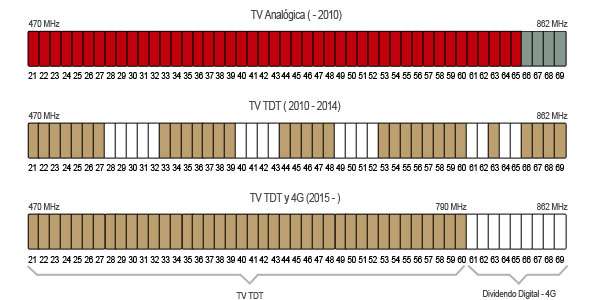4G-LTE filter
4G-LTE filter is a low-pass filter, to be used in DTT-reception installations (both collective and individual) if one wants to keep the old UHF TV antenna, previously installed, without the risk of interferences caused by the 4G-LTE transmitters,[1] the latest standard generation of cellphones.[2]
These filters are only required for existing facilities as for new installations in urban or rural areas, antennas and amplifiers sold from the application of the new standard should already be configured to receive, with good signal gain, only TV channels from 21 to 60 of the UHF band, the other higher channels (former TV channels 61 to 69) being attenuated.
Interference between 4G LTE and DTT
4G LTE is the fourth generation mobile phone standard. In urban areas, the 4G uses a frequency band located between 2500 MHz and 2600 MHz, and therefore is quite far from the TV band for causing any type of interference problem.
In rural areas, however, the major operators have asked to use part of the UHF band. Since the UHF frequency band is not expandable, it was agreed that television broadcasting should limit its number of channels. Thus, the frequency band dedicated to the TV will be between 470 MHz and 790 MHz (channels 21-60), and the 4G LTE will use the frequency band between 790 and 860 MHz (former TV channels 61 to 69) being the interval separating the two bands (DTT and 4G) of only 1 MHz, so that there is a risk of interferences [1] in the areas close to the 4G-LTE transmitting towers.[1] In practice, the band used (790 to 862 MHz), called Digital dividend, this will not become a real problem until 2015 (or the start of the 4G deployment in these areas).[3]
Digital dividend

Digital dividend to frequency 06 MHz (TV Channels 61 to 69) assigned by the plan for the New UHF Frequency Band distribution agreed in The World Radio Congress (WRC-07) which identified 108 MHz of Digital Dividend Spectrum from 698 to 806 MHz for ITU-R Regions 2-1 and nine countries in Regions 3-2, including China, India, Japan and Rep. of Korea.[4]
This Digital dividend is used to improve the coverage of the 4G-LTE new standard in rural areas, needed with the arrival of 4G-LTE and requires therefore the redistribution of UHF frequency band. Starting from January 2015 (in some countries), the main mobile operators will begin to deploy their networks of very high band width "True 4G" or LTE using the frequency previously attributed to TV Channels 61 to 69, which is known as "digital dividend".[4]
See also
References
- 1 2 3 Brouillage des fréquences TNT par la 4G. Clubic.com.
- ↑ Guide pratique World_ENG_Final (PDF). French government. pp. –.
- ↑ "Can the 4G LTE signal cause interference to your TV reception? - Wired Store". wiredstore.com.au. Retrieved 2018-07-18.
- 1 2 The benefits of digital dividend. www.4gamericas.org.